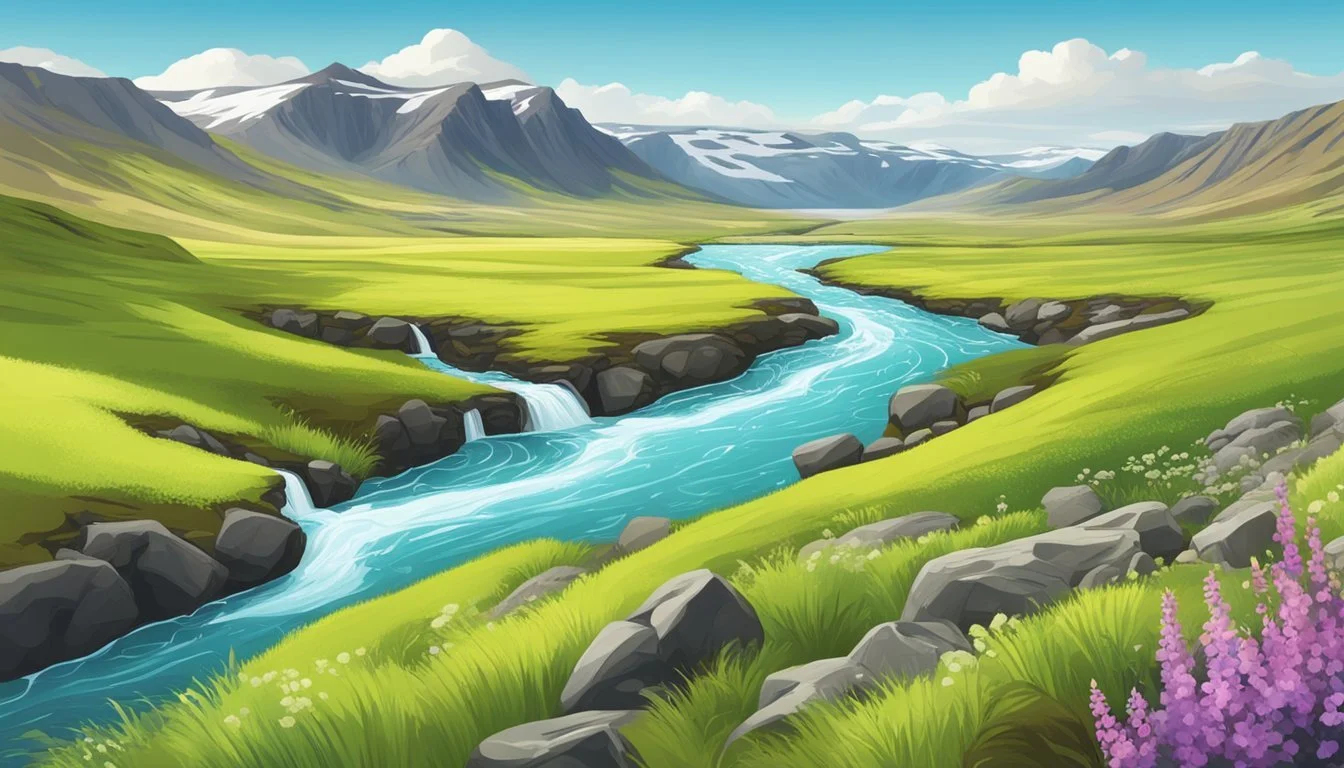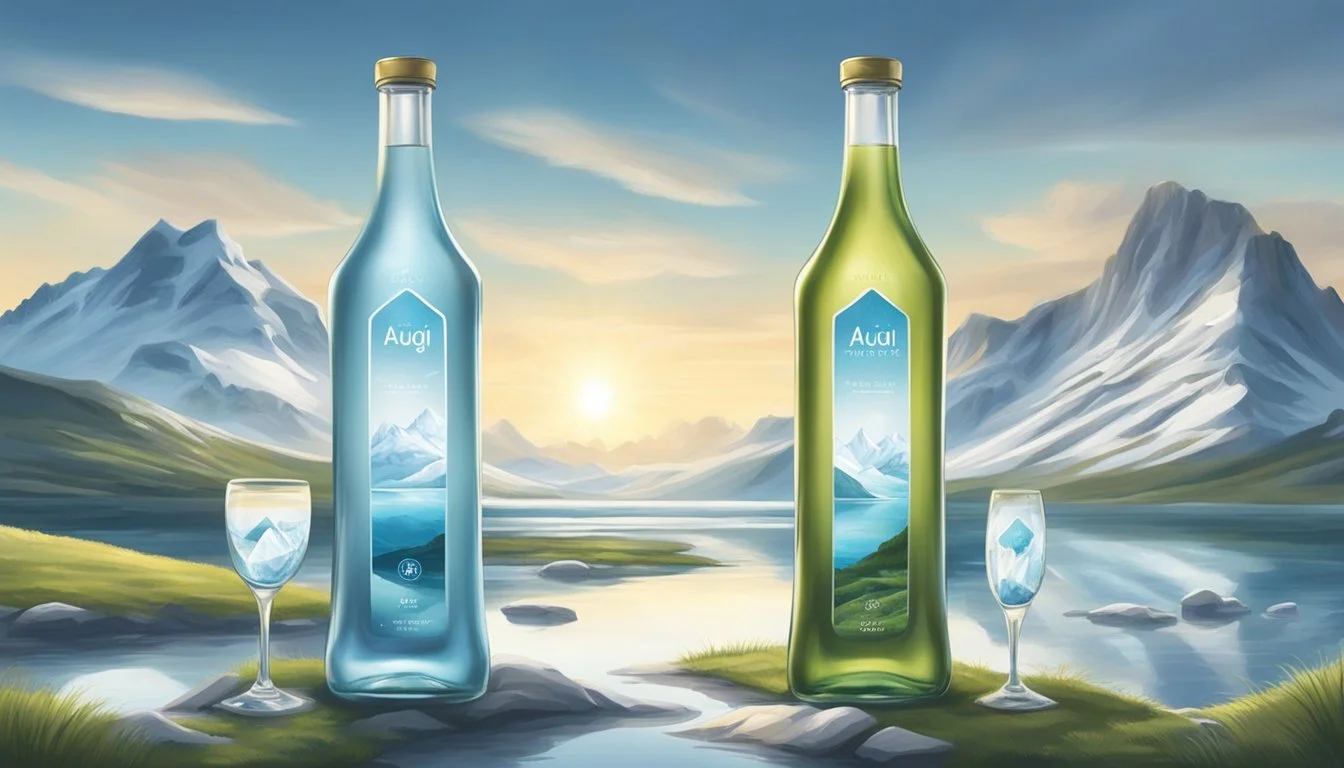Icelandic Glacial vs. Augi
A Comparison of Premium Bottled Waters
Choosing the right bottled water can often seem like a daunting task with so many options available. In this post, the focus is on two popular brands: Icelandic Glacial and Augi. For those seeking the purest option, Icelandic Glacial stands out with its reputation for exceptional purity and balanced mineral content straight from Iceland's pristine environment.
On the other hand, Augi offers a different proposition as it comes from the Leesburg, Virginia municipal water supply. While it may not have the glacial allure of its counterpart, some might find Augi’s slightly sulphuric taste, which some perceive as unique, to be a distinguishing feature. Each brand has its loyal following, reflecting different priorities in the bottled water market.
For consumers, the choice between Icelandic Glacial and Augi boils down to a preference for natural glacial water versus a locally sourced option. This article will explore various aspects of both waters to help readers make an informed decision based on taste, source, and overall quality.
Understanding the Basics of Bottled Water
Bottled water is a popular choice for hydration, encompassing various types and brands. This section explores what bottled water is, its categories, and the associated health and hydration benefits.
What Is Bottled Water?
Bottled water refers to water that is packaged in bottles for commercial sale. It can originate from multiple sources including natural springs, wells, and municipal supplies. Companies often purify the water through various methods such as distillation, deionization, or reverse osmosis to ensure safety and improve taste.
Consumers choose bottled water for its convenience, portability, and perception of cleanliness. Additionally, some brands market their water as having unique characteristics based on the source and mineral content, influencing consumer preferences.
Categories of Bottled Water
Bottled water falls into different categories based on its source and treatment process:
Spring Water: Comes from an underground formation that naturally flows to the surface.
Purified Water: Undergoes processes like distillation or reverse osmosis to remove impurities.
Mineral Water: Contains natural minerals and is often collected from springs or wells.
Artesian Water: Drawn from a confined aquifer where water is under pressure.
Sparkling Water: Contains carbon dioxide, making it fizzy.
Each type has specific characteristics and may appeal to different consumer needs.
Health and Hydration Benefits
Bottled water provides essential hydration, crucial for maintaining bodily functions such as temperature regulation, waste elimination, and joint lubrication. Brands often highlight the purity and mineral content of their water, promoting potential health benefits.
For instance, mineral water may provide additional nutrients like calcium, magnesium, and potassium, which can support health. Some bottled waters are marketed as being free from contaminants, suitable for individuals with specific health concerns.
In daily life, the ease of transporting bottled water supports a consistent hydration habit. Staying hydrated contributes to overall well-being, enhancing energy levels, cognitive function, and physical performance.
Icelandic Glacial and Augi: Brand Profiles
Icelandic Glacial and Augi offer contrasting experiences in bottled water, both with unique origins and attributes. This detailed look at both brands gives insight into their distinct characteristics.
Icelandic Glacial: Origin and Distinctiveness
Icelandic Glacial water originates from the renowned Ölfus Spring in Iceland. Formed over 5,000 years ago, this spring is naturally protected by layers of lava rock, ensuring pristine purity.
The water is notable for its naturally high pH of 8.4, making it alkaline. It also prides itself on being the world's first CarbonNeutral certified water.
The brand is managed by Icelandic Water Holdings hf., which ensures exclusive rights to commercialize this unique source. The company's approach emphasizes both sustainability and purity, bottling the water directly at the source with minimal processing.
Augi: Background and Offerings
Augi is bottled from the municipal water supply of Leesburg, Virginia. It's a purified water, which involves additional treatment processes to ensure quality.
There is a notable sulfuric taste in the water, which varies in preference among consumers. The brand is not necessarily marketed on purity or high pH but rather on its unique taste profile.
Augi is best known for providing an accessible option for purified drinking water, rather than emphasizing natural sourcing. This positions it differently in the market when compared to brands like Icelandic Glacial.
Water Quality and Purity
To compare Icelandic Glacial and Augi bottled waters, it's essential to evaluate their water quality and purity. The subsequent subtopics will delve into the source and natural filtration, mineral content and health implications, and pH levels and alkalinity for both brands.
Source and Natural Filtration
Icelandic Glacial is sourced from the Ölfus Spring in Iceland, formed over 5,000 years ago. This spring is known for its natural purity, filtering rain and snowmelt through volcanic rock. This process ensures the water is untouched by human hands until bottled.
Augi, on the other hand, derives from the municipal water supply in Leesburg, Virginia. It undergoes purification processes to remove contaminants. Although treated, it lacks the same natural filtration as Icelandic Glacial, which impacts its organic purity.
Mineral Content and Health Implications
Icelandic Glacial water offers a rich mineral balance due to its journey through volcanic rock. It contains minerals like calcium, magnesium, and silica, contributing to its crisp taste and potential health benefits like better hydration and mineral supplementation.
In contrast, Augi undergoes a purification process that removes most natural minerals. This may result in a significantly lower mineral content compared to Icelandic Glacial. Consequently, Augi may not offer the same health benefits related to natural mineral intake.
pH Levels and Alkalinity
The pH level of water reflects its acidity or alkalinity, impacting taste and potential health benefits. Icelandic Glacial water boasts a naturally high pH level, typically around 8.4, indicating alkaline qualities. This can aid in improving the body's pH balance and support metabolic functions.
Augi water, being purified municipal water, usually has a pH closer to neutral, often around 7.0. While this is safe for consumption, it does not provide the same alkaline benefits that Icelandic Glacial offers. The neutrality in pH might not cater to consumers seeking the health advantages of alkaline water.
Taste and Consumer Experience
When comparing Icelandic Glacial and Augi bottled water, assessing the flavor profiles and understanding the consumer experiences provides a clear view of their differences.
Flavor Profile Analysis
Icelandic Glacial offers a clean and crisp taste. Its low mineral content and balanced pH level result in a flavor that many describe as pure and refreshing. Consumers frequently note its smooth texture, free from bitterness due to minimal Total Dissolved Solids (TDS).
Augi, sourced from Leesburg, Virginia, presents a distinct taste. Some consumers mention a slight sulfuric flavor, which can border on fishy. While the taste isn't necessarily unpleasant, it stands in contrast to the neutrality often preferred in bottled water.
Brand Perception and Reputation
Icelandic Glacial is highly regarded among consumers, presenting itself as a premium brand. Its reputation for purity and clean taste has earned it a loyal following. It is considered slightly more difficult to find, but those who seek it out do so for its well-regarded quality.
Augi, in contrast, is perceived as a more standard option. While it does have a unique taste profile, it doesn't enjoy the same level of consumer adoration as Icelandic Glacial. Its slightly unusual flavor can be a hit or miss among drinkers, making it less universally appealing.
Environmental Sustainability
Examining the environmental sustainability of Icelandic Glacial and Augi involves looking at their water sourcing standards, packaging and carbon footprint, and company commitments to sustainability. These factors provide insight into the ecological responsibilities upheld by each company.
Water Sourcing Standards
Icelandic Glacial sources its water from the Ölfus Spring in Iceland, which is one of the largest and most pristine natural springs in the world. The company emphasizes the purity and sustainable withdrawal methods to ensure minimal impact on the aquifer.
Augi, on the other hand, uses municipal water from Leesburg, Virginia. While it undergoes purification, this sourcing method raises questions about its renewability and potential strain on local water resources. There is less focus on preserving a natural source compared to Icelandic Glacial's practices.
Packaging and Carbon Footprint
Icelandic Glacial uses recyclable PET packaging and claims to be the world's first carbon-neutral bottled water brand. Efforts include offsetting their carbon emissions and using renewable energy in their production processes. Their packaging is tailored to reduce waste and ensure sustainability.
Augi uses standard PET bottles, which can be recycled but do not differentiate in terms of sustainable innovations. The carbon footprint associated with the local treatment and bottling of municipal water is not particularly highlighted or counterbalanced by specific carbon-offset programs.
Company Commitments to Sustainability
Icelandic Glacial has made significant strides in environmental sustainability. Their carbon neutrality certification ensures that all greenhouse gases produced are offset. They also engage in regular environmental initiatives to maintain their eco-friendly status.
Augi does not emphasize significant sustainability initiatives. It operates more as a standard bottled water company without particular commitments to reducing environmental impact. The focus is more on product purification rather than broad environmental sustainability practices.
By comparing these practices, it becomes evident that Icelandic Glacial has a more comprehensive approach to sustainability. They take extensive measures to ensure both their sourcing and packaging methods are environmentally friendly, while Augi lacks significant sustainability initiatives.
Comparison of Icelandic Glacial and Augi
Icelandic Glacial and Augi bottled waters each offer distinct characteristics, from their sources and filtration to mineral content and sustainability practices. Examining these aspects helps determine which bottled water might better meet various consumer preferences.
Filtration Process and Purity Standards
Icelandic Glacial is sourced from Iceland's Ölfus Spring, renowned for its natural filtration through layers of lava rock. This creates a high purity level without requiring extensive artificial purification methods. The water is naturally alkaline and has a pH level of 8.4, contributing to its repute.
Conversely, Augi is a purified water from the Leesburg, Virginia, municipal water supply. It undergoes a rigorous purification process to meet safety standards, making it a safe choice for consumers. However, its taste has been noted to have a slight sulphuric edge, which some may find off-putting.
Mineral Content and Health Benefits
Icelandic Glacial boasts naturally occurring minerals due to its filtration through volcanic rock, which may contribute to its health benefits. The water contains essential minerals such as calcium and magnesium, enhancing its nutritional value.
Augi, being a purified water, generally lacks the natural mineral content found in spring water. While it is safe to drink and free from contaminants, it does not provide the same level of minerals as Icelandic Glacial. Consumers looking for mineral-rich options may prefer Icelandic Glacial over Augi.
Taste Experience and pH Balance
Icelandic Glacial is often praised for its clean, crisp taste, attributed to its natural filtration and high pH level of 8.4. This naturally alkaline pH may appeal to those who believe in the health benefits of alkaline water.
Augi, despite its rigorous purification, has been critiqued for its slightly sulphuric flavor. While this taste is not necessarily harmful, it may not be preferable to all consumers. The difference in taste experiences can significantly influence consumer preferences.
Sustainability and Environmental Practices
Icelandic Glacial stands out for its commitment to sustainability. It is the world's first CarbonNeutral certified bottled water, with its source being sustainably managed to ensure a minimal environmental impact. The company also focuses on eco-friendly packaging solutions.
On the other hand, Augi's sustainability practices are less prominently highlighted. While it meets purification standards, there is limited information on its environmental commitments. For eco-conscious consumers, Icelandic Glacial’s strong focus on sustainability may be a decisive factor.
Consumer Preference and Market Presence
Icelandic Glacial enjoys a solid market presence, recognized for its premium quality and sustainability initiatives. Its distinct characteristics and marketing as a high-end product attract a specific segment of consumers willing to pay a premium for quality and environmental responsibility.
Augi, sourced from a municipal supply and marketed primarily as a purified water option, caters to a different demographic. It may appeal more to consumers seeking an affordable and safe drinking water option, even if it lacks the premium appeal of Icelandic Glacial.
Icelandic Glacial and Augi offer distinct benefits, appealing to different consumer preferences based on purity, taste, mineral content, and sustainability.
Bottom Line: Which Water Wins?
Icelandic Glacial is sourced from Iceland’s Ölfus Spring, known for its purity and low mineral content. This makes it a refreshing choice with a crisp taste.
Augi, on the other hand, is a purified water from the Leesburg, Va., municipal supply and is often noted for its affordability. Some find a slight sulphuric taste, which can be polarizing.
Price is a significant factor. Icelandic Glacial is typically more expensive due to its imported status and environmental branding. Augi offers a budget-friendly option, making it accessible for more consumers.
Comparison Table:
Feature Icelandic Glacial Augi Source Ölfus Spring, Iceland Leesburg, Va., municipal supply Price Higher Lower Mineral Content Low Variable Taste Crisp, pure Slight sulphuric note Availability Specialty stores Widely available
Both waters provide hydration but cater to different preferences and budgets. Icelandic Glacial stands out for its natural source and clean taste, appealing to those willing to pay a premium. Augi's purified water caters to those seeking quality at a lower price, albeit with a potential taste variation.
More About Icelandic Glacial
Acqua Panna vs Icelandic Glacial: Which Bottled Water is Better?
Aquafina vs Icelandic Glacial: Which Bottled Water is Better?
Arrowhead vs Icelandic Glacial: Which Bottled Water is Better?
Boxed Water vs Icelandic Glacial: Which Bottled Water is Better?
Core Hydration vs Icelandic Glacial: Which Bottled Water is Better?
Deer Park vs Icelandic Glacial: Which Bottled Water is Better?
Essentia vs Icelandic Glacial: Which Bottled Water is Better?
Eternal vs Icelandic Glacial: Which Bottled Water is Better?
Ice Mountain vs Icelandic Glacial: Which Bottled Water is Better?
Icelandic Glacial vs 1907water: Which Bottled Water is Better?
Icelandic Glacial vs 7-Select: Which Bottled Water is Better?
Icelandic Glacial vs Alkaline88: Which Bottled Water is Better?
Icelandic Glacial vs Antipodes: Which Bottled Water is Better?
Icelandic Glacial vs Aqua Carpatica: Which Bottled Water is Better?
Icelandic Glacial vs Big Chill: Which Bottled Water is Better?
Icelandic Glacial vs Big Win: Which Bottled Water is Better?
Icelandic Glacial vs BodyArmor: Which Bottled Water is Better?
Icelandic Glacial vs Cascade Mountain: Which Bottled Water is Better?
Icelandic Glacial vs Castle Rock: Which Bottled Water is Better?
Icelandic Glacial vs CBD Living: Which Bottled Water is Better?
Icelandic Glacial vs Crystal Geyser: Which Bottled Water is Better?
Icelandic Glacial vs Crystal Lake: Which Bottled Water is Better?
Icelandic Glacial vs Erewhon: Which Bottled Water is Better?
Icelandic Glacial vs Essence pH10: Which Bottled Water is Better?
Icelandic Glacial vs Hawaii Volcanic: Which Bottled Water is Better?
Icelandic Glacial vs Hawaiian Springs: Which Bottled Water is Better?
Icelandic Glacial vs Just Water: Which Bottled Water is Better?
Icelandic Glacial vs Kirkland Signature: Which Bottled Water is Better?
Icelandic Glacial vs LIFEWTR: Which Bottled Water is Better?
Icelandic Glacial vs Liquid Death: Which Bottled Water is Better?
Icelandic Glacial vs Mananalu: Which Bottled Water is Better?
Icelandic Glacial vs Mountain Valley Spring Water: Which Bottled Water is Better?
Icelandic Glacial vs Nestle Pure Life: Which Bottled Water is Better?
Icelandic Glacial vs Open Water: Which Bottled Water is Better?
Icelandic Glacial vs Perrier: Which Bottled Water is Better?
Icelandic Glacial vs Poland Spring: Which Bottled Water is Better?
Icelandic Glacial vs Proud Source: Which Bottled Water is Better?
Icelandic Glacial vs Pure Life: Which Bottled Water is Better?
Icelandic Glacial vs Purely Sedona: Which Bottled Water is Better?
Icelandic Glacial vs Refreshe: Which Bottled Water is Better?
Icelandic Glacial vs Richard's Rainwater: Which Bottled Water is Better?
Icelandic Glacial vs San Pellegrino: Which Bottled Water is Better?
Icelandic Glacial vs Simple Truth: Which Bottled Water is Better?
Icelandic Glacial vs Smartwater: Which Bottled Water is Better?
Icelandic Glacial vs Solan de Cabras: Which Bottled Water is Better?
Icelandic Glacial vs Starkey: Which Bottled Water is Better?
Icelandic Glacial vs Talking Rain AQA: Which Bottled Water is Better?
Icelandic Glacial vs The Well: Which Bottled Water is Better?
Icelandic Glacial vs Topo Chico: Which Bottled Water is Better?
Icelandic Glacial vs Tru Alka: Which Bottled Water is Better?
Icelandic Glacial vs Waiakea: Which Bottled Water is Better?
Icelandic Glacial vs Weird Water: Which Bottled Water is Better?
Icelandic Glacial vs Whole Foods 365: Which Bottled Water is Better?
Icelandic Glacial vs Whole Foods Italian Still Mineral water: Which Bottled Water is Better?
Icelandic Glacial vs Zephyrhills: Which Bottled Water is Better?
Icelandic Glacial vs HFactor: Which Bottled Water is Better?








